Food Hub Campaign
Kelly Chim, Charlene Chiu, Austin Lam, Olivia Santoro

Names of Community Partner Collaborators
Little Mountain Neighbourhood House
Riley Park Community Garden
Point of Contact: Joanne MacKinnon
Introduction
Little Neighbourhood Mountain House offers programs and initiatives that support fellow residents in the community. From childcare, to counselling and art therapy, to programs for newcomers settling in Vancouver, LMNH serves its community in various ways. For our project, we worked directly under LMNH’s Food Hub – a program they created to address food insecurity within the community. At the time our project began, Food Hub was wrapping up their Collective Food Resilience toolkit (a free downloadable infographic/guide that’s meant to help other community-based organisations create food security strategies). Their goal for us was to help them increase their reach so that more people in the community would know about Food Hub and hopefully more people would also download their toolkit.
Background Information about the Community Partner
In 1978, three staff members and a group of volunteers came together to form Little Mountain Neighbourhood House in order to address the local, regional and national issues that residents in the community were experiencing. Nearly fifty years later, LMNH remains a grassroots, volunteer-driven organisation and continues to serve the community by offering programs and initiatives that strengthen neighbourhood life.
LMNH’s Food Hub addresses food insecurity within the community by increasing access to healthy food. Through their Riley Park Community Garden, Yard Garden Harvest Project and UBC Farm Practicum Program, community members are able to build relationships with one another as well as how to grow their own food. Some of the produce grown went towards LMNH’s weekly food distribution. This program provided non-judgmental, low-barrier spaces where individuals who are experiencing food insecurity can come and feel welcomed and supported. Lastly, Food Hub created their collective food resilience toolkit. This toolkit aimed to help other community-based organisations create food security strategies by offering practical examples, resources and tips for implementation.
Problems We Addressed
The problem we had to solve in this project was the lack of engagement on LMNH’s social media. In order to promote LMNH’s toolkit (previous project) and raise awareness on the issue of food insecurity within the community, we had to analyse their previous posts’ analytics and determine how to best increase their engagement. Some of our challenges included not being familiar with their organisation’s structure and working around their system of manually recording post statistics.
As our project focus is on food insecurity, we worked closely with the staff members of LMNH’s Food Hub. We aimed to raise awareness of LMNH’s toolkit and their available programs so that LMNH could see an increase in the number of volunteers and people participating in their events. However, as the length of our project does not permit us to see if more people signed up for future LMNH events, our success will be based upon the analytics of the posts we created. We discussed various methods of promoting their toolkit, such as reaching more people through other platforms such as TikTok or using Instagram stories to engage more of their current followers. Eventually, we decided on simply posting Instagram posts so that it would be more straightforward, and made clear that this project was an extension of the previous toolkit project.
Solution and Implementation
As our project is an extension of LMNH’s toolkit project, we specifically worked on creating posts that would highlight the toolkit’s “action phase”.
In order to achieve our goal of increasing engagement, we decided to introduce faces, i.e., real people, on their feed as it was something lacking in their recent posts. This was a major factor in our decision on how to create the “action phase” posts. Based on this factor, we created posts which introduced key members of the Food Hub and their roles in order to demonstrate how action was taken by people using the toolkit. The process of creating each post included interviewing staff, copywriting, designing graphics, editing, and receiving approval, before they were ready to be posted. These posts not only introduced the members, it also highlighted how various programs within Food Hub functioned during the pandemic and the lessons staff members took away from working in Food Hub during a time of high food insecurity.
Although we were mainly targeting a higher social engagement on Instagram, our posts were also uploaded on Facebook and Twitter to widen LMNH’s reach. Keeping in mind their previous project’s design, we stuck with a relatively similar design for our first post which was intended as a transition post to our later posts. Additionally, we also made use of their custom-made watercolour graphics in our posts for continuity. The biggest difference with their previous posts was our use of photos and non-technical language. In total, five posts were created.
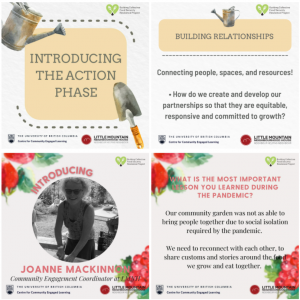
The graphics above are a few of the posts we created for the project.
Example caption:
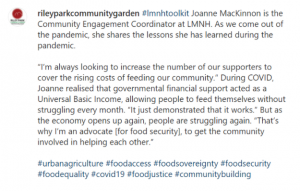
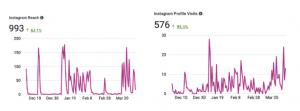
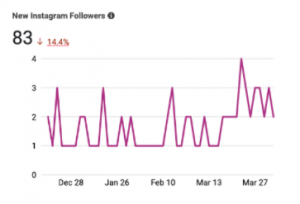
As of April 4, we have only posted three of the five posts (of which the third one was taken down and is to be reposted), garnering a total of 950 post impressions and reaching 781 unique accounts. Compared to LMNH’s previous 28 posts about the toolkit, which have garnered around 3100 post impressions and reached around 2300 unique accounts. According to the average reach per post (260 unique accounts for our project and 82 unique accounts for the previous campaign), it appears we are still relatively successful in reaching a large number of people with few posts. In addition, our average engagement is higher, with an average of 27 likes per post compared to their average of 5.5 likes per post. We have also gained new followers in the short duration of our posting (March 22 – April 1) and an increasing number of profile visits. This indicates that we have been able to increase the content engagement rate for LMNH.
Self-Evaluation
Overall, working with our CEL partner has been an interesting learning experience. While we have yet to finish our campaign, the content that we have already posted is doing well. This is evident from the increased engagement rates before and after we started our campaign. Our solution, a series of posts highlighting the work of Food Hub staff, introduces the staff members to their community and shares their stories about the programs they lead. As LMNH does not use plug-ins on their website and is unable to measure link clicks and downloads on their website, we do not know if we have achieved the original goal of increasing the exposure and engagement rate of their toolkit. However, we were able to achieve their goal of sharing their stories.
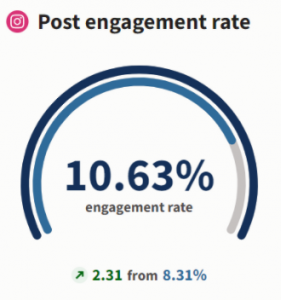
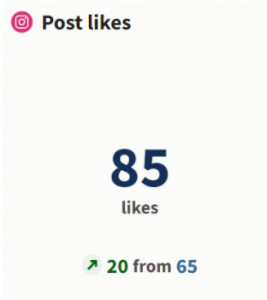
Although we have been somewhat successful with implementing our solution, we have also faced a few issues throughout this project. Communication has been a big problem throughout the course of the project. While our group had some miscommunication issues at the start with regards to delegation of work, we were able to resolve this quickly. On the other hand, we’ve consistently had miscommunication with the CEL partner despite efforts to rectify the situation. An example of this is our partner changing their mind on the type of content they want and the changes they want made despite the copyediting and graphics being approved in previous meetings. In addition, there were miscommunications within the group as emails got lost between team members, so on many occasions the graphic designer and copywriters were unaware of changes our partner wanted before posting. This has thus lengthened the time needed for each post and impeded the full use of our content strategies (posting times).
While we worked in line with the learning objectives of the course (conduct basic content analysis of social media data, design, implement, and evaluate social media strategies to achieve organisational and communication goals), the project did not fully enable us to achieve a better understanding of them. As we had limited access to LMNH’s social media accounts, the data that we could retrieve was also restricted. While we were able to conduct an analytics report for the toolkit project we wrapped up, later content analysis was conducted purely through Hootsuite and Meta Business which did not have all the information. This lack of information combined with the miscommunication negatively impacted our attempts at a comprehensive social media strategy.
As we started working with our CEL partner at the same time as the course started, we found ourselves lacking knowledge on content creation and social media marketing skills and strategies. In retrospect, we should have created a more effective and efficient line of communication with our partner. And while we did have weekly meetings with our point of contact, these meetings were not as efficient as they could have been in terms of editing or preparing content.
Working on this project has shown us the work that needs to go into a successful social media campaign and has increased our appreciation for the coordination needed in social media marketing, especially with regards to social organisations like LMNH. It also allowed us to learn about the difficulties of food insecurity within the community. Despite the setbacks we faced, it has been a fruitful learning experience and a great opportunity to get real-world experience.
I admire your group’s drive and dedication to fulfill your Commuity Partner’s goal of engagement. I think you did a lot of research about your partner and their previous campaigns which helped you create an even more successful one. Perhaps you could be more specific with how the communication issues with your partner stunted some work and show some examples if you have any. I think the work that LMNH is doing for their community is wonderful and would really like to see their Food Hub succeed!
I thought that you guys did a great job on your blog post and video! The structure you implemented in your blog made it easy to understand and easily digestible. Your posts looked great and I think you applied your analytic conclusions well to the greater context of your goals. I would just recommend some rephrasing of grammar, particularly in the last sentence of your “Problems we Addressed” paragraph as I feel that rewording would make your point stronger. I also personally found your paragraph about course objective in the self-evaluation to be slightly negative as from my understanding you were able to conduct a good analysis with what you did have access to and I also think that you were able to apply past results of analytic results in order to inform your project which accurately engaged with course concepts. However, one thing that I was left wondering after reading your post was if there was a specific demographic (age range, gender etc.) that you were trying to reach though I know you are targeting the Little Mountain area it might be valuable to include that information. Overall Congrats on finishing your project! I thought it turned out great!